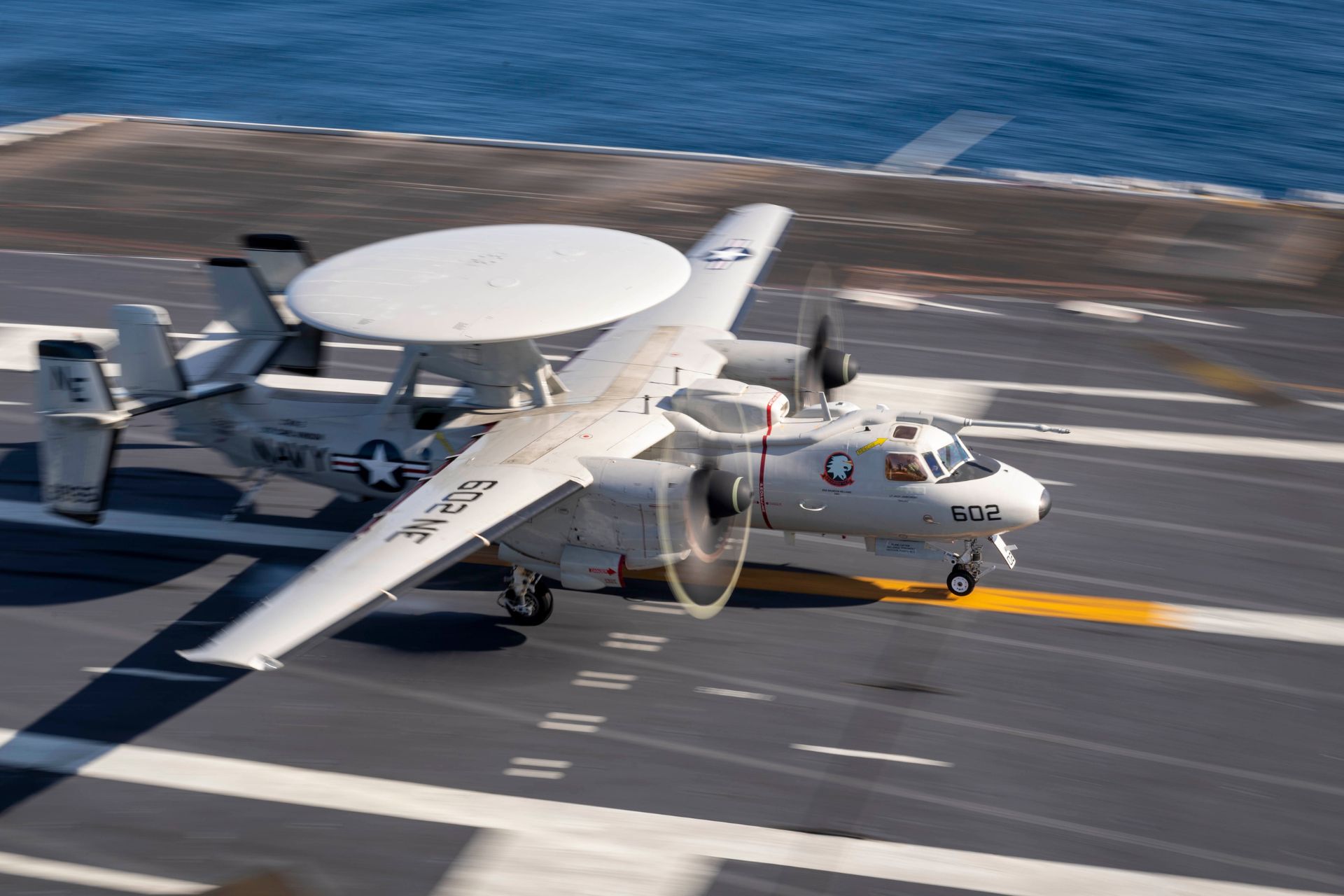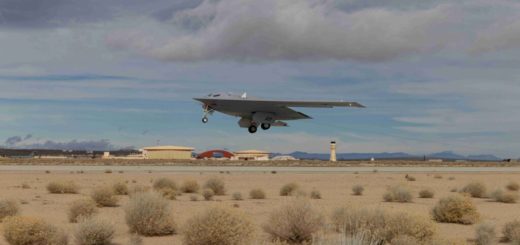Poland Partners with Northrop Grumman to Explore E-2D Advanced Hawkeye Capabilities

{loadposition bannertop}
{loadposition sidebarpub}
On November 1, 2024, Northrop Grumman signed memorandums of understanding with Poland’s Air Force Institute of Technology (Instytut Techniczny Wojsk Lotniczych, ITWL) and the company Exence, marking a strategic step towards enhancing Poland’s airborne command and control capabilities. This partnership aims to explore the integration of the E-2D Advanced Hawkeye, an airborne surveillance and command aircraft developed by the American defense giant, into Poland’s national defense systems and their interoperability with NATO structures.
Follow Army Recognition on Google News at this link
An E-2D Advanced Hawkeye lands on the flight deck aboard Nimitz-class aircraft carrier USS Carl Vinson (Picture source: US DoD)
The primary goal of this partnership is to assess how the E-2D Advanced Hawkeye could bolster Poland’s defense capabilities. Designed by Northrop Grumman for the U.S. Navy, this all-weather surveillance and control aircraft is recognized for its advanced detection and communication capabilities. Equipped with the AN/APY-9 radar, which provides 360-degree coverage with both electronic and mechanical scanning capabilities, the E-2D offers unparalleled detection, even against stealth threats such as the Su-57 and J-20 aircraft. This next-generation radar, combined with modern communication systems and advanced mission computers, gives military forces a rapid, in-depth understanding of the battlefield, enabling precise mission management and enhanced missile defense. These attributes make the E-2D a critical asset for airspace protection and real-time coordination with NATO assets, ensuring optimal interoperability in multinational operations.
In addition to its detection capabilities, the E-2D integrates a fully digital cockpit and upgraded systems, enabling its five-member crew—comprising two pilots and three systems operators—to undertake a variety of missions. Its flexibility allows it to conduct diverse operations, from coordinating aerial strikes to providing support for ground forces and intercepting threats. With aerial refueling capability, the E-2D can significantly extend its flight endurance, maximizing its range and persistence in strategic environments. These capabilities position the E-2D as a core element of U.S. air and missile defense architecture, both in coastal and overland areas, providing extensive coverage and bolstering the protection of national and allied interests.
Janice Zilch, Vice President of Multi-Domain Command and Control Programs at Northrop Grumman, emphasized the importance of building a robust allied force in response to Poland’s defense needs. She added that this agreement not only supports Poland’s development of command and control capabilities but also strengthens its private and national industrial base, enhancing the country’s security in coordination with allied partners.
By collaborating with key players such as Exence and ITWL, Northrop Grumman is well-positioned to assist Poland in developing modern defense capabilities while ensuring that the E-2D aligns seamlessly with NATO assets. This collaboration may also benefit the training and adaptation of Polish command and control operations, enabling Poland to respond more effectively to regional threats and to contribute to collective defense operations within NATO.
Currently, Poland uses the Swedish Saab 340 AEW for its aerial surveillance needs, which it obtained second-hand from the UAE Air Force due to the end of the Saab 340 production line. The E-2D could serve as a complement or enhancement to Poland’s advanced detection capabilities. The integration of the E-2D Advanced Hawkeye within the Polish Armed Forces would significantly reinforce Poland’s air defense and command capabilities. This aircraft, equipped with the AN/APY-9 radar for precise 360-degree threat detection, is crucial for Poland given its geographical location and current security challenges.
Moreover, the E-2D can coordinate complex operations in real-time, enhancing interoperability with NATO systems. Its capacity to simultaneously track and monitor multiple aerial and naval targets allows for effective threat management. Integrating this platform would offer Poland improved situational awareness, strengthening airspace security and enhancing its contribution to NATO’s collective defense operations.

{loadposition bannertop}
{loadposition sidebarpub}
On November 1, 2024, Northrop Grumman signed memorandums of understanding with Poland’s Air Force Institute of Technology (Instytut Techniczny Wojsk Lotniczych, ITWL) and the company Exence, marking a strategic step towards enhancing Poland’s airborne command and control capabilities. This partnership aims to explore the integration of the E-2D Advanced Hawkeye, an airborne surveillance and command aircraft developed by the American defense giant, into Poland’s national defense systems and their interoperability with NATO structures.
An E-2D Advanced Hawkeye lands on the flight deck aboard Nimitz-class aircraft carrier USS Carl Vinson (Picture source: US DoD)
The primary goal of this partnership is to assess how the E-2D Advanced Hawkeye could bolster Poland’s defense capabilities. Designed by Northrop Grumman for the U.S. Navy, this all-weather surveillance and control aircraft is recognized for its advanced detection and communication capabilities. Equipped with the AN/APY-9 radar, which provides 360-degree coverage with both electronic and mechanical scanning capabilities, the E-2D offers unparalleled detection, even against stealth threats such as the Su-57 and J-20 aircraft. This next-generation radar, combined with modern communication systems and advanced mission computers, gives military forces a rapid, in-depth understanding of the battlefield, enabling precise mission management and enhanced missile defense. These attributes make the E-2D a critical asset for airspace protection and real-time coordination with NATO assets, ensuring optimal interoperability in multinational operations.
In addition to its detection capabilities, the E-2D integrates a fully digital cockpit and upgraded systems, enabling its five-member crew—comprising two pilots and three systems operators—to undertake a variety of missions. Its flexibility allows it to conduct diverse operations, from coordinating aerial strikes to providing support for ground forces and intercepting threats. With aerial refueling capability, the E-2D can significantly extend its flight endurance, maximizing its range and persistence in strategic environments. These capabilities position the E-2D as a core element of U.S. air and missile defense architecture, both in coastal and overland areas, providing extensive coverage and bolstering the protection of national and allied interests.
Janice Zilch, Vice President of Multi-Domain Command and Control Programs at Northrop Grumman, emphasized the importance of building a robust allied force in response to Poland’s defense needs. She added that this agreement not only supports Poland’s development of command and control capabilities but also strengthens its private and national industrial base, enhancing the country’s security in coordination with allied partners.
By collaborating with key players such as Exence and ITWL, Northrop Grumman is well-positioned to assist Poland in developing modern defense capabilities while ensuring that the E-2D aligns seamlessly with NATO assets. This collaboration may also benefit the training and adaptation of Polish command and control operations, enabling Poland to respond more effectively to regional threats and to contribute to collective defense operations within NATO.
Currently, Poland uses the Swedish Saab 340 AEW for its aerial surveillance needs, which it obtained second-hand from the UAE Air Force due to the end of the Saab 340 production line. The E-2D could serve as a complement or enhancement to Poland’s advanced detection capabilities. The integration of the E-2D Advanced Hawkeye within the Polish Armed Forces would significantly reinforce Poland’s air defense and command capabilities. This aircraft, equipped with the AN/APY-9 radar for precise 360-degree threat detection, is crucial for Poland given its geographical location and current security challenges.
Moreover, the E-2D can coordinate complex operations in real-time, enhancing interoperability with NATO systems. Its capacity to simultaneously track and monitor multiple aerial and naval targets allows for effective threat management. Integrating this platform would offer Poland improved situational awareness, strengthening airspace security and enhancing its contribution to NATO’s collective defense operations.





